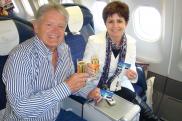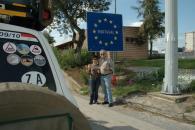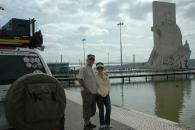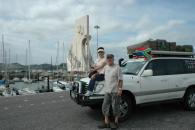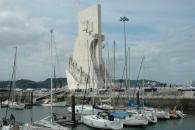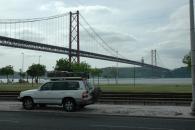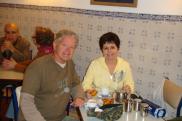Profile
Blog
Photos
Videos
Day 207 - 27 May 2010 - Homeward bound and random reflections
These last few days in Portugal afforded us an opportunity to reciprocate hospitality for Pete and Fran who were visiting Portugal, including visits to Sintra, Cascais and surrounding areas and Lisbon itself.It was really wonderful to have them with us.
Then final preparations for closing down the house, getting to the airport and flight home via London (thank you to our friends Helga and Jorg Fischer who gave us voyager miles to upgrade to business class... what a way to finish the trip!).
It also gave us the chance to randomly reflect on seven months of travel... (and 30 547km later)
* Definitely a trip of two parts - Africa, challenging, exciting, full of the unexpected, different at every turn and a bit risky in places.Europe, easier, civilised, predictable, but still wonderful in completely different ways.
* We had very mixed emotions as we drove onto the ferry in Tunis, bound for Sicily - we had made it through the length of Africa, but somehow it had been easier than expected.There was almost a sense of anti-climax after 120 days "on the road".
So what made Africa a challenge, and why not to take it lightly:
1. It was John, Marina and the Beast - on their own, no one to help them out of tight spots, no travelling companions, no mechanical or medical support.
2. There was a sense of the unknown.Although we had travelled in central and southern Africa, and flown into east Africa, from Malawi northwards it was new driving territory, and travel books, private blogs and the wider internet don't prepare you for everything.
3. The preparation for the trip was quite intense, from carnet and visas, to medical/dental checkups, first aid, bush mechanics, getting and mastering the satnav and its software, the satellite phone and various items of personal security equipment. And of course, the Plan, covering every aspect of places, distances, things to do, Toyota garages, fuel, embassies, bookings, costs....
4. The strategic decision regarding the right vehicle, and the way we accessorised it for the trip.The Beast, a Toyota Landcruiser, 100 series VX, 4, 2 litre diesel, was fantastic!Tyres got punctured/shredded and a couple of things broke but it did not once let us down or leave us stranded.Fantastic quality.
5. We did "smell the roses" along the way.Compared to some, 120 days is a long time from Cape Town to Cap Blanc (in Tunisia), but others we met along the way felt we were rushing a bit!It is true we did have some deadlines especially towards the end, but overall we are satisfied with the balance between "purpose" and "pleasure".
6. Costs are a barrier to this trip.For a start, a decent vehicle and the carnet made doubly expensive due to Egypt's stricter requirements.Even for a basic trip, the cost of fuel, vehicle servicing and repairs, food, camping, park fees, insurance, immigration, transit and various other fees all mount up.If you want a bit of comfort along the way (lodges, Nile cruise, and scuba diving) costs mount very quickly.
7. Excluding South Africa, the roads range from passable tar and good gravel to dangerous pot holed and ragged tar and appalling, even dangerous, gravel.These are always amplified by kamikaze bus/truck drivers, un-roadworthy vehicles, donkey carts, cows, goats and other domestic animals, bicycles, and of course pedestrians.Having said that, most of the route we followed (via east Africa) could be done on what passes for tar, the only exception being the Northern Frontier district of Kenya.Still, we did just under 5 000km on gravel as we followed a few roads less travelled.
8. In some places, personal security is an issue.Northern Kenya has Somali rebels/bandits who do attack or interfere with travellers, and Sudan has Darfur, the South/North secession tension and a President indicted by the World Court, any of which may still disrupt the stability of the region.And, there is always the underlying tension regarding water and the use of the Nile, which has implications beyond Ethiopia, Sudan and Egypt.Elsewhere, common sense must be exercised in places like Nairobi and Cairo.Happily, we had no problems and probably felt most comfortable in Malawi and (ironically) Sudan.
9. Apart from the roads, driving is a challenge (RHD up to Kenya and LHD from Ethiopia).Some of the issues include: Tanzanian buses (with drivers allegedly drunk, drugged or both), trucks (right of weight before right of way), Ethiopia (pedestrians and animals, etc) and Egypt (vehicles with no lights at night, five lanes of traffic in three lanes of road, etc...) not for the faint hearted.
10. Travel costs - in Egypt, apart from the carnet, immigration costs are higher than most other countries. Libya has its own challenges, with the Colonel's insistence on travellers having a "guide" who has to be transported, fed, housed, paid and tipped.On top of this, they even imposed a transit tax a week or two before we arrived.The only upside in Libya is that it had the cheapest fuel we experienced (the equivalent of R1,00 per litre).
11. Patience is an important ingredient when entering Egypt and Libya.In both these countries we had to register the Beast and get local Arabic number plates.It all takes time.For the rest of the trip we were surprised at how quickly border crossings were completed.Seldom more than one hour for exit from one and entry into another.
12. Hygiene and cleanliness - other than in the upmarket lodges and hotels, where normal western standards were present, you had to turn a blind eye to conditions elsewhere.In many places we had to deal with cold water showers in cubicles that were devoid of hooks or shelves to hang towels and clothes etc (floor too filthy) and smelly."squat" toilets without toilet paper (sometimes below the shower... just don't drop anything whilst showering), and eating places inundated with flies and stray cats.There were toilets that were unmentionable, no sign of maintenance or cleaning for decades, walls blackened and no running water.It is difficult to believe that these would be acceptable to anybody, and yet there they were, next to a petrol station in one instance and an urban hotel in another (both in Ethiopia).
13. The ferry between Wadi Halfa and Aswan on Lake Nasser is both unavoidable and disgusting.You could barely turn around in the so called first class cabin, the toilets were overused, stinking and let's not forget filthy, and whilst the food was just about edible, the dining area (and the cabins) was infested with roaches.Still, it all added to the experience and we happily survived unscathed.In addition to the hygiene factors, the ferry is itself a barrier for the trip.It only runs once a week (excluding those weeks that coincide with religious holidays or breakdowns) and if you are not there on Wednesday when it leaves Wadi Halfa you wait until the following Wednesday.Transporting motor vehicles is an additional challenge due to the fact that they do not travel on the ferry but on a separate barge operating its own timetable.There can be delays at both ends, and in our case we had to wait two days in Aswan for the barge to arrive.And then there is the cost factor as it is more expensive than the first class standard we experienced between Tunis and Palermo (Sicily) or between Portsmouth and Santander (Spain).
What have been some of the highlights that have been memorable for both of us...
South Africa:
* Beautiful Cape Town and our special photo with Table Mountain to start the trip.
* Patrick & Brigitte Daly who opened up their home to us and hosted our farewell party
* Johannesburg to Karoo - and our encounter with the ostrich.Happily she survived intact, and we had no material damage.
Namibia:
* Wide open spaces, and you do have time to enjoy them as the roads and facilities are pretty good.
* The desert and Etosha National Park - the Park is not cheap compared with South Africa, but standards were generally very good for camping.
* Swakopmund - love this place, with its still present German heritage, the Atlantic pounding in on the beach, and of course, the Beach Pub... a great place to have a drink and watch the sun go down!
Zambia
* Tongabezi and Livingstone Island & Victoria Falls - special, special experiences.
* The bicycle culture and they get used to transport everything.
* Developing as a country, but still a long way to go.
* Camping at Pioneer Camp outside Lusaka.
Malawi
* Friendly people, despite the poverty.
* The Lake and especially camping at Senga Bay, right on the Lake.
* David Livingstone, whose positive memory is still promoted.
Tanzania
* Game reserves, including Ruaha, Selous, Ngorongoro and Serengeti.
* Tsetse flies - not dangerous, but very uncomfortable when they bite.They took to John in a big way.
* Buses and their kamikaze drivers - really quite dangerous.
Kenya
* Meeting up with John's cousin Rod Evans and wife Debbie - we really enjoyed the short time with you.
* The Rift Valley and the soda lakes - spectacular scenery.
* Jungle Junction in Nairobi - a must for private overland travellers, meeting others, sharing information, car and bike servicing.
* The Northern Frontier District - shocking roads, but at least they were dry for us... and no Somali shiftas.
* Christmas at Elsa's Kopje (Meru National Park), New Year's Eve spent in solitary splendour at Henry's Camp in Marsabit, and New Year's Day entering Ethiopia.
Ethiopia
* The ever-present pressure of population, even in the remotest parts of the country.
* The source of Blue Nile on Lake Tana, and the Blue Nile Falls a bit down-stream... no so spectacular now, but still worth the walk over the Portuguese Bridge.
* Historic Rock hewn churches in Lalibela - the sort of thing one only sees on National Geographic channel, but there we were walking through them, taking our own pictures.
* Our new friend Graham Nundy, working in Addis, for his hospitality and helping us find our way round, especially to get the Beast fixed.Enjoyed having you with us into the Omo Valley.
* Overall, a sorry excuse for a country.Although never colonised, it never really progressed, and today they have nobody but themselves to blame for that!
Sudan
* Khartoum/Omdurman - the sense of history abounds in the two parts of what is really the same city.
* Confluence of the two Niles - you really can see the difference in the colour between the White and Blue Niles as they converge.
* Friendly people - despite the potential for politic nonsense, the individual we came into contact were always friendly, and we had no concerns about wild-camping on our own in the desert.
* The 3 nights camping in Wadi Halfa with Alain & Chistine Arnaud (fellow overlanders and now friends) and Alexey - great company.
* The Ferry!A disgusting and dirty old rust bucket, which is memorable for all the wrong reasons!Nevertheless, it was punctual and the Beast made its journey successfully on its own on a separate barge.
Egypt
* The Pyramids signalled the end of our Cape to Cairo odyssey... it was great to be there and get the photo.In many ways,Abu Simbel and the Temples of Karnak and Luxor were more impressive.
* The Nile Cruise - a different perspective on this great river, the life-blood of North East Africa.
* Red Sea diving - pity we got sick, but we saw and did enough to know that we will return.
* Egyptian driving ... while driving in Johannesburg is partial training, nothing prepares you for driving at night without lights on!These people are crazy!
* Dani and Sim Olivi - our friends and neighbours from Johannesburg who did the Nile Cruise with us, were in Cairo to welcome us after our epic 17 hour drive from Luxor and shared our photo opportunity at the Giza Pyramids.
Libya
* Leptis Magna - said to be some of the best preserved Roman ruins in the world.
* Desert Road - definitely not winding, but certainly long!Our longest day in terms of kilometres travelled - 1100!
* The people including our guide Wesam.Without exception the people we met were friendly and helpful, especially Wesam.At first, we were not too thrilled at the idea of having to travel with a guide, but Wesam was a great travel companion and we enjoyed having him with us.
Tunisia
* Matmata with its troglodyte (below ground) houses, and a location used in one of the Star Wars films - the legacy is still visible.
* Medina and the Souk (the Old Town of Tunisia).An intriguing maze of narrow alleys, crowded pavements, shops and the Great Mosque.And yes, we did do some shopping!
* In complete contrast the new Tunis, with high-rise buildings, smart hotels wide boulevards and motorways.
* Apart from old and new, there is also the mix of heritage - obviously Arab, but being an ex French colony the country and city still embrace their colonial influences.Worth another visit.
- comments




